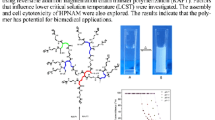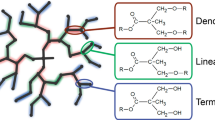Abstract
An isocyanate-terminated hyperbranched polymer (HBI) was successfully synthesized by reacting hyperbranched polyester (BoltornTM HB-20) with isophorone diisocyanate (IPDI). Gel permeation chromatography (GPC) was used to monitor the molecular weight and its distribution changes during the synthesis. The structure and composition of IPDI were characterized by 1H and 13C nuclear magnetic resonance (NMR) spectroscopy. The structure of HBI was confirmed by one-dimensional 1H, 13C NMR, and distortionless enhancement by polarization transfer (DEPT) NMR spectroscopy as well as two-dimensional heteronuclear multiple bond coherence (2D-HMBC) and heteronuclear single quantum coherence (HSQC) NMR spectroscopy. Furthermore, HBI was reacted with methoxypolyethylene glycols (MPEG) to obtain a water-dispersible polyisocyanate with hyperbranched structure.
Graphical abstract
















Similar content being viewed by others
References
Inoue K (2000) Functional dendrimers, hyperbranched and star polymers. Prog Polym Sci 25 (4):453-571. https://doi.org/10.1016/S0079-6700(00)00011-3
Wei D, Liao B, Huang J et al (2019) Fabrication of castor oil-based hyperbranched urethane acrylate UV-curable coatings via thiol-ene click reactions. Prog Org Coat 135:114-122. https://doi.org/10.1016/j.porgcoat.2019.05.039
Wei D, Huang X, Zeng J et al (2020) Facile synthesis of a castor oil-based hyperbranched acrylate oligomer and its application in UV-curable coatings. J Appl Polym Sci 137 (36). https://doi.org/10.1002/app.49054
Perocheau Arnaud S, Hashemi P, Mischnick P et al (2020) Optimized synthesis of highly reactive UV-curable hyperbranched polyester acrylates. J Coat Technol Res 17 (1):127-143. https://doi.org/10.1007/s11998-019-00247-w
Xiang H, Wang X, Xi L et al (2018) Effect of soft chain length and generation number on properties of flexible hyperbranched polyurethane acrylate and its UV-cured film. Prog Org Coat 114:216-222. https://doi.org/10.1016/j.porgcoat.2017.10.019
Duarah R, Karak N (2018) High performing smart hyperbranched polyurethane nanocomposites with efficient self-healing, self-cleaning and photocatalytic attributes. New J Chem 42 (3):2167-2179. https://doi.org/10.1039/c7nj03889e
Zhong H, Gao X, Zhang X et al (2020) Improving the shale stability with nano-silica grafted with hyperbranched polyethyleneimine in water-based drilling fluid. J Nat Gas Sci Eng 83. https://doi.org/10.1016/j.jngse.2020.103624
Hou LR, Gao J, Ruan H et al (2020) Mechanical and thermal properties of hyperbranched poly(epsilon-caprolactone) modified graphene/epoxy composites. J Polym Res 27 (2). https://doi.org/10.1007/s10965-020-2008-x
Shan P, Chen N, Hao C et al (2020) Facile and solvent-free synthesis of a novel bio-based hyperbranched polyester with excellent low-temperature flexibility and thermal stability. Industrial Crops and Products 148. https://doi.org/10.1016/j.indcrop.2020.112302
Duarah R, Deka A, Karak N (2020) Multifaceted bioinspired hyperbranched polyurethane nanocomposite as a non-contact triggered self-healing material. Express Polym Lett 14 (6):542-555. https://doi.org/10.3144/expresspolymlett.2020.44
Aly KI, Abdel-Rahman MA, Qutai MM (2018) Photoactive linear and hyperbranched polyesters based on 4-methylcyclohexanone and 4-tert-butylcyclohexanone moieties in the main chain: synthetic methodology, characterization and cytotoxicity. J Polym Res 25 (8):15. https://doi.org/10.1007/s10965-018-1579-2
Guo PF, Zhang ZL, Zhang YW et al (2020) Controllable synthesis of terminal carboxyl hyperbranched polyester and their retarding effect on concrete. J Polym Res 27 (8):9. https://doi.org/10.1007/s10965-020-02188-0
Jovicic M, Radicevic R, Pavlicevic J et al (2020) Synthesis and characterization of ricinoleic acid based hyperbranched alkyds for coating application. Prog Org Coat 148. https://doi.org/10.1016/j.porgcoat.2020.105832
Zhang J, Ren H, Chen P et al (2019) Preparation and properties of waterborne polyurethane with star-shaped hyperbranched structure. Polymer 180. https://doi.org/10.1016/j.polymer.2019.121690
Zhang J, Hu CP (2009) Synthesis, characterization and mechanical properties of polyether-based aliphatic polyurethane elastomers composed of hyperbranched polyester segments. Acta Polymerica Sinica (9):867-873. https://doi.org/10.3321/j.issn:1000-3304.2009.09.004
Zhang J, Hu CP (2008) Synthesis, characterization and mechanical properties of polyester-based aliphatic polyurethane elastomers containing hyperbranched polyester segments. Eur Polym J 44 (11):3708-3714. https://doi.org/10.1016/j.eurpolymj.2008.08.019
Bao C-L, Wang L-S, Zhang A-Q (2009) Synthesis and properties of waterborne hyperbranched aliphatic polyester clear coats. J Taiwan Inst Chem E 40 (2):174-179. https://doi.org/10.1016/j.jtice.2008.07.013
Zhang Q-Z, Li B-B, Sun D et al (2016) Preparation and characterization of PVA membrane modified by water-soluble hyperbranched polyester (WHBP) for the dehydration of n-butanol. J Appl Polym Sci 133 (24). https://doi.org/10.1002/app.43533
Hu H, Yuan Y, Shi W (2012) Preparation of waterborne hyperbranched polyurethane acrylate/LDH nanocomposite. Prog Org Coat 75 (4):474-479. https://doi.org/10.1016/j.porgcoat.2012.06.007
Yin W, Zeng X, Li H et al (2011) Synthesis, photopolymerization kinetics, and thermal properties of UV-curable waterborne hyperbranched polyurethane acrylate dispersions. J Coat Technol Res 8 (5):577-584. https://doi.org/10.1007/s11998-011-9338-x
Lin X, Zhang S, Qian J (2014) Synthesis and properties of a novel UV-curable waterborne hyperbranched polyurethane. J Coat Technol Res 11 (3):319-328. https://doi.org/10.1007/s11998-013-9520-4
Fiori DE (1997) Two-component water reducible polyurethane coatings. Prog Org Coat 32 (1):65-71. https://doi.org/10.1016/S0300-9440(97)00076-3
Lomölder R, Plogmann F, Speier P (1997) Selectivity of isophorone diisocyanate in the urethane reaction influence of temperature, catalysis, and reaction partners. J Coat Technol Res 69 (868):51-57. https://doi.org/10.1007/BF02696250
Ono H-K, Jones FN, Pappas SP (1985) Relative reactivity of isocyanate groups of isophorone diisocyanate. Unexpected high reactivity of the secondary isocyanate group. Journal of Polymer Science: Polymer Letters Edition 23 (10):509-515. https://doi.org/10.1002/pol.1985.130231003
Hatada K, Ute K, Oka K-I et al (1990) Unambiguous 13C-NMR assignments for isocyanate carbons of isophorone diisocyanate and reactivity of isocyanate groups in Z - and E-stereoisomers. J Polym Sci, Part A: Polym Chem 28 (11):3019-3027. https://doi.org/10.1002/pola.1990.080281111
Wang L-M, Pan T-Y, Shi X-M et al (2005) Characterization of isophrone diisocyanate(IPDI) by NMR spectroscopy. Chinese Journal of Magnetic Resonance 22 (1):79-84. https://doi.org/10.3969/j.issn.1000-4556.2005.01.012
Zhang J, Yang K, Zhang Z et al (2019) Molecular structure characterization of hydroxyl-terminated hyperbranched polyester. Chinese Journal of Functional Polymers 32 (2):206-211,254. https://doi.org/10.14133/j.cnki.1008-9357.20180614002
Xing J, Ye Q (2003) Technical progress of the water dispersible polyisocyanates. Chemical Propellants and Polymeric Materials (in Chinese) 1 (4):15-18. https://doi.org/10.3969/j.issn.1672-2191.2003.04.006
Funding
This study was supported by Shanghai Leading Academic Discipline Project (No.B 502).
Author information
Authors and Affiliations
Corresponding author
Ethics declarations
Conflict of interest
No conflict of interest exits in the submission of this manuscript, and manuscript was approved by all authors for publication. We declared that materials described in the manuscript, including all relevant raw data, will be freely available to any scientist wishing to use them for non-commercial purposes, without breaching participant, confidentiality.
Additional information
Publisher's Note
Springer Nature remains neutral with regard to jurisdictional claims in published maps and institutional affiliations.
Rights and permissions
About this article
Cite this article
Zhang, J., Tian, HT., Zhang, YT. et al. Synthesis and characterization of an isocyanate-terminated hyperbranched polymer and its waterborne study. J Polym Res 28, 149 (2021). https://doi.org/10.1007/s10965-021-02499-w
Received:
Accepted:
Published:
DOI: https://doi.org/10.1007/s10965-021-02499-w




